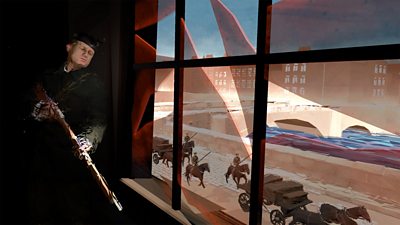
After investigating the opportunities of Virtual Reality, we've learnt a lot over the last year. Here are a few of the things we've found out - which might help in your own experiments in VR.
2. Users won’t always do what you want them to.
If you’re an early VR adopter it’s easy to forget that not everybody will use the technology as naturally as you now do. A great example of this is the way we’ve observed that many new users still don’t necessarily look around very much when they’re wearing a headset, which can feel rather deflating if you have spent a lot of time creating an amazing 360 world and dreaming up ingenious methods to direct their attention to it! However, this doesn’t necessarily mean they can’t feel immersed or won’t enjoy it. In these early days, sometimes the challenge is about creating a good experience for people who don’t interact very much, but rewarding the people who do. This might feel frustrating from a creative point of view, but whilst the majority of the world has yet to try any VR, recognizing this behaviour may help to make it more accessible to the elusive mainstream audience. If you have any opportunity to observe real users trying out your VR content, or anybody else’s for that matter, it is definitely an insight worth having.
3. Photorealism is not the be-all and end-all for creating believable experiences.
Animation or stylised computer generated visuals may not be the first port of call for many forms of traditional storytelling, but for immersive experiences they are worth a second thought. (a story about a family of Syrian refugees trying to cross the Mediterranean) and (about the 1916 uprising in Ireland) both tackled serious topics with a visual style that might not normally be considered appropriate for a typical current affairs or documentary piece, but ultimately made it feasible for us to depict both a current and historical event in a way that we would not otherwise have been able to do. It’s true that this style is not to everybody’s taste, but in general this did not appear to be a big hindrance to the sense of immersion and emotional engagement that we observed. Viable, live-action ‘true VR’ experiences may be on their way, but for now my advice would be not to discount the freedom that animation or CG can offer on account of wanting your story to be taken seriously. Put another way – when faced with limited resources, I would suggest prioritising other things above trying to achieve accurate photorealism, such as good sound and well thought out interactions.

4. Porting between platforms doesn’t necessarily give consistency of experience.
We tried to do a ‘simple’ port of an experience built for an Oculus Rift to a 360 video that could be viewed with a . Of course, we knew we would lose the interactive elements from this transition, but we still felt the story was enough without them to make it worthwhile, so that more people could see it. In this case, although this worked from a technical point of view, the experience itself did not feel consistent in terms of its feel and emotional impact. For example, characters felt smaller and further away, which made the story feel less intimate. The lighting also wasn’t quite suitable for the smartphone display, which detracted from the atmosphere, and even the length of the experience felt a little too long when viewed on a lower-end device. Since then, I have also seen colleagues trying to make the transition between other platforms and finding that everything requires a lot more effort than originally thought. To many techies I’m sure this will not be surprising, and most of the issues I describe are fixable, but to anybody setting out on a VR adventure, the lesson here is not to assume that the transition between platforms is just a technical job – it may require new editorial thinking too to make sure the experience is consistent in terms of the impact you are trying to make. From a resourcing point of view, don’t assume that building an experience for one platform or display means you will get another for free, even if you use the same game engine (e.g. ) to do it.
5. Spend more time on sound. R&D’s sound-lead VR experience.
, has really lead the way for us in terms of showing where immersive, dynamic, truly comes into its own. We Wait also used elements, and many users we tested with noticed and appreciated the way the audio felt ‘accurate’ from their point of view. Personally, I would put high quality spatial sound near the top of the list for any future immersive projects. Well-crafted audio alone can have an incredibly immersive power, but if nothing else, it only makes sense that your amazing immersive visuals are accompanied by equally high-quality immersive sound – they deserve it! For more on the techniques used in The Turning Forest .
6. Spare a thought for the Web.
Ahh the web…let us not forget you. We have made one web-based VR pilot so far, , which used Web GL and to create an experience that could be viewed within a browser across phones, tablets, and even desktop, with no downloads required! This experiment has been very promising, although of course, there are limitations to what can be done here at the moment, with one of the main issues being the fact that not all browsers support this yet, and those that do are not all doing it consistently, so the experience isn’t always very stable. The web standard is in its early days, but a recent trip to the first has given me much reason for hope. The volume of thought and enthusiasm going into this area even at this very early stage is really encouraging, and the stage is set for what could be the only open VR standard going. So the takeaway here is not to overlook this possibility for your project, you never know – it might offer you the interoperability and the chance at higher audience reach that you seek.
7. Smartphone experiences fare better with a headset.
We created and tested with Â鶹ԼÅÄ Audiences a couple of VR prototypes that could be viewed on a smartphone either as a ‘window on the world’ experience (i.e. you can wave your phone around in 360 degrees to discover the virtual world around you, without putting on a headset) or as an experience that you could pop into a ‘smartphone adaptor’ headset such as a Google Cardboard. We noticed that users tended to rate the pilot more positively, and were more likely to say they would try more things like it in the future, when viewed through a headset. In fairness, there are probably several angles to this, such as an element of headset novelty that is difficult to discount, plus the fact that in some cases the pilots were probably slightly better optimised for use in a headset rather than simply on a smartphone screen. It should also be noted that this finding was more pronounced for more VR-like content (i.e. those that had immersive features such as spatial sound, and interactive elements that the user could control) than for straight 360 video. My personal interpretation here is that we should find it very encouraging that people are responding well to the headsets and enjoying the format, although for now, offering these two options is still a very good way to try and keep audience reach as broad as possible, while people don’t have headsets at home.
8. It’s tempting to try a lot of new innovations all at once, but it pays to limit your variables.
The same can be said for any R&D-type project of course, but it really holds true here so it’s worth laboring the point. For example, you might be interested in trying out clever user interactions, narrative structures, graphics, avatars, methods for moving people through space or between scenes, but you don’t necessarily need to play with all of these things at once, and in fact, it’s probably a bad idea. Decide what the most valuable thing is that you’re trying to explore, and then keep everything else as simple as you can (especially as you can often find that even the simple stuff can prove tricky in VR Land!). This way you’re more likely to be able to draw some meaningful conclusions from the work, but also make it more manageable and keep scope-creep down to a minimum. Honestly, unless you’ve got a team of seasoned VR pros with a Hollywood budget, then if you think you’ve kept it simple…stop…and make it even simpler.There are lots of reasons to be positive about VR, although with so many factors at play I suspect it will be some time before we can be sure exactly where we are on the hype curve. Until then though, some cautious optimism with a good dose of pragmatism feels a sensible way forward. Happy experimenting!
- -
- More on Virtual Reality and 360 Video:
- from day
-

Immersive and Interactive Content section
IIC section is a group of around 25 researchers, investigating ways of capturing and creating new kinds of audio-visual content, with a particular focus on immersion and interactivity.
